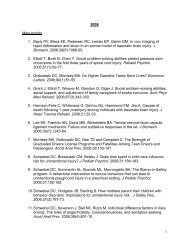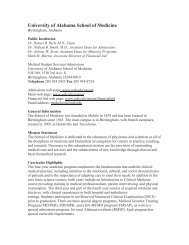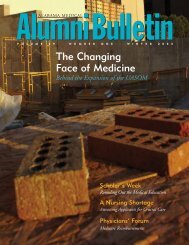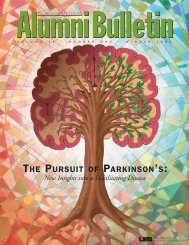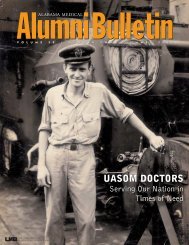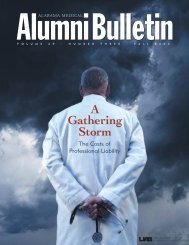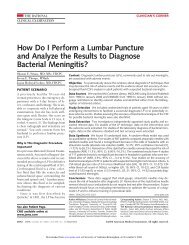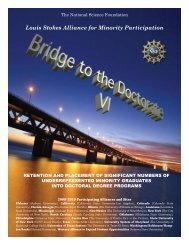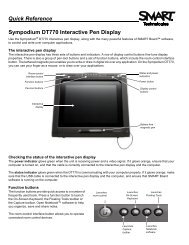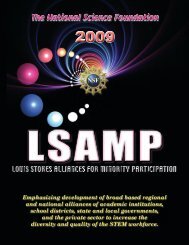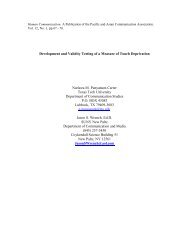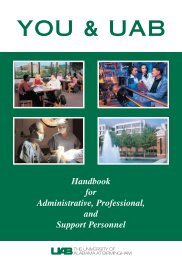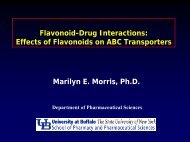AnnuAl RepoRt - University of Alabama at Birmingham
AnnuAl RepoRt - University of Alabama at Birmingham
AnnuAl RepoRt - University of Alabama at Birmingham
Create successful ePaper yourself
Turn your PDF publications into a flip-book with our unique Google optimized e-Paper software.
UAB UTC Fe<strong>at</strong>ured in RITA Spotlight Newsletter<br />
Each month, RITA’s <strong>University</strong> Transport<strong>at</strong>ion Centers<br />
Program publishes a much anticip<strong>at</strong>ed, widely dissemin<strong>at</strong>ed<br />
newsletter highlighting noteworthy findings or<br />
other significant accomplishments reported by one <strong>of</strong> the<br />
<strong>University</strong> Transport<strong>at</strong>ion Centers in its n<strong>at</strong>ional network.<br />
This past June, 2010, the UTC Spotlight Newsletter fe<strong>at</strong>ured<br />
findings from the UAB UTC study which examined<br />
and analyzed the impact <strong>of</strong> urban sprawl on delays emergency<br />
service providers are likely to experience while<br />
traveling to an emergency site as well as from such sites<br />
to appropri<strong>at</strong>e hospitals or trauma centers.<br />
By way <strong>of</strong> background, urban sprawl is an increasingly<br />
common development p<strong>at</strong>tern in the US, characterized<br />
by low-density construction, poor street connectivity,<br />
and single-use zoning. Urban planning and public health<br />
research show th<strong>at</strong> urban sprawl increases trip distances<br />
and traffic density for personal automobile travel, which<br />
decrease travel efficiency. These findings led researchers<br />
to hypothesize th<strong>at</strong> urban sprawl may also be associ<strong>at</strong>ed<br />
with delays in the movement <strong>of</strong> emergency medical<br />
service (EMS) personnel and equipment to a site and<br />
subsequently to a tertiary care facility such as a trauma<br />
center.<br />
As described in his recently completed research project<br />
report, Urban Sprawl and Pre-hospital Emergency Care<br />
Time, M<strong>at</strong>thew Trowbridge, MD, MPH, and his team<br />
measured the rel<strong>at</strong>ionship between county-level urban<br />
sprawl and EMS response times in the US. Dr. Trowbridge<br />
determined urban sprawl to be associ<strong>at</strong>ed with<br />
increased EMS response time and a higher probability <strong>of</strong><br />
delayed EMS arrival following motor vehicle crashes. The<br />
probability <strong>of</strong> delayed EMS arrival is nearly twice as high<br />
in counties with prominent sprawl characteristics compared<br />
to counties with less urban sprawl.<br />
UAB UTC’s research confirm<strong>at</strong>ion <strong>of</strong> urban sprawl’s<br />
associ<strong>at</strong>ion with increased EMS response times underscores<br />
the importance <strong>of</strong> considering future land use and<br />
its potential impact on the delivery <strong>of</strong> emergency care<br />
services. Moreover, we know the lagging <strong>of</strong> medical<br />
infrastructure behind residential development in sprawling<br />
suburban areas distances such communities from<br />
major trauma and tertiary care centers. Less expensive<br />
home prices in sprawling urban areas tend to <strong>at</strong>tract lower<br />
income popul<strong>at</strong>ions, including the elderly, who <strong>of</strong>ten have<br />
limited access to transport<strong>at</strong>ion. D<strong>at</strong>a have confirmed th<strong>at</strong><br />
both demographic groups are <strong>at</strong> higher risk for emergency<br />
medical issues and the need for EMS services. EMS<br />
service is increased per capita in the same sprawling areas<br />
where it is more difficult and expensive to provide.<br />
Working to reconfigure street networks in existing<br />
suburban areas to reduce their sprawling characteristics<br />
will take time. In the interim, it is reasonable to consider<br />
reorganizing pre-hospital and hospital resources to better<br />
compens<strong>at</strong>e for the impact <strong>of</strong> urban sprawl on emergency<br />
response. The results <strong>of</strong> this research, combined with<br />
inform<strong>at</strong>ion from other rel<strong>at</strong>ed UAB UTC-sponsored<br />
research projects, are being used to help develop land<br />
use and public safety recommend<strong>at</strong>ions. It is hoped these<br />
recommend<strong>at</strong>ions will help change the way communities<br />
are planned and the way hospital and other health care<br />
resources are alloc<strong>at</strong>ed.<br />
The UAB UTC is working to help achieve livable, sustainable,<br />
and healthy communities through projects like<br />
Urban Sprawl and Pre-hospital Emergency Care Time<br />
and other complementary research efforts. For a copy <strong>of</strong><br />
the UTC Spotlight Newsletter fe<strong>at</strong>uring this UAB UTC<br />
research project or for additional inform<strong>at</strong>ion about this<br />
project or the other UAB UTC-sponsored projects, we<br />
invited you to visit the UAB UTC website,<br />
www.uab.edu/utc.<br />
Specific Accomplishments 49



